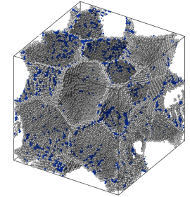Magnetic and Chemical Contributions to Interface: A Monte Carlo Simulation Study
M. Ångqvist,
E. Fransson,
E. Jedvik,
and
J. Lövgren
Bachelor′s Thesis
(2012)
doi: 20.500.12380/177138
Download PDF

This report studies implications of chemical and magnetical contributions to a Fe-Cr alloy using Monte Carlo simulations of a modified Ising Model. Through order parameter the properties of the alloy has been characterised and the phase diagram of Fe-Cr , which exhibits the main characteristics of the experimentally obtained phase diagram has been constructed. For low temperatures and intermediate concentrations a new ordered phase, which resembles the ternary Heusler alloy, has been found together with the corresponding phase boundary. The Variance Constrained Semi-Grand Canonical ensemble was successfully applied to compute the interface free energy as a function of concentration and the value of the interface free energy in the [100]-direction has been computed. From the interface free energy the miscibility gap, where phase separation between chromiumrich and iron-rich clusters form, has been constructed. Also the spinodal, the limit of where metastable phases can exist, has been found. A pronounced size dependence of the difference between spinodals and binodals has been found and the assumption that the difference at system size of 203 is negligible is proven to be wrong.


